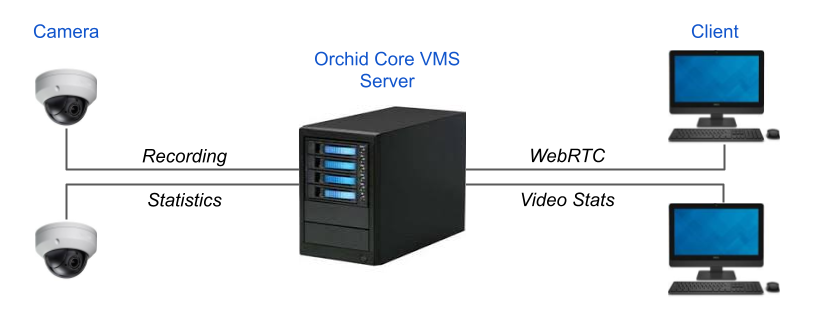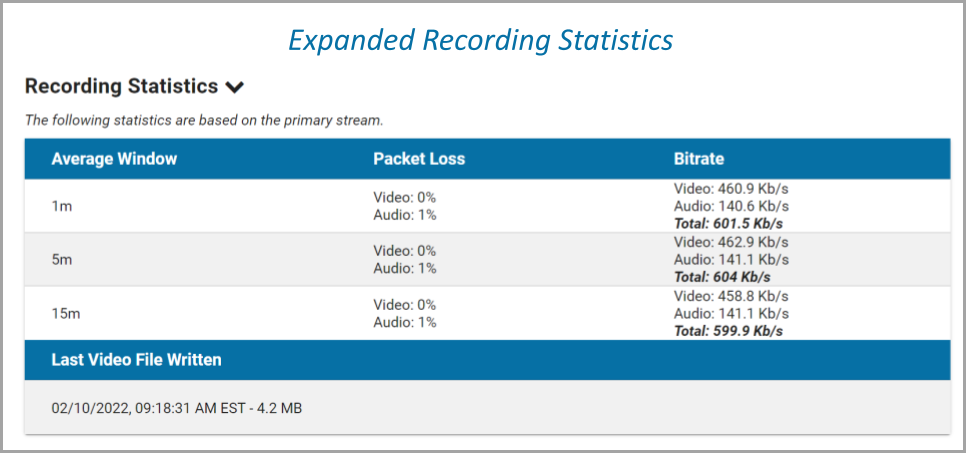If video in Orchid Core VMS is unavailable or degraded, you may be experiencing packet loss in one of two locations: either between the camera and Orchid Core VMS, or between Orchid Core VMS and the viewing client. The diagram below indicates which check methods are available to test the different connections.

Run a Check Using the Recording Statistics
Beginning with version 2.16, Orchid Core VMS provides a new way to gauge the performance of the recording stream. The Recording Statistics feature displays packet loss and bit rate numbers for the video being transmitted from the camera, and also shows when the last video file was recorded.
- To view the Recording Statistics, go to the Camera Configuration screen and click on the Expand icon to view the Recording Statistics section.

The Recording Statistics will provide the percentage of packet loss at the recording stream, averaged over three time periods: 1 minute, 5 minutes, and 15 minutes. A comparison of these averages may give you some indication of the transmission quality both currently and over a longer period of time.
The goal, of course, is to have 0% packet loss on the recording stream so that the archived video is not degraded. The presence of packet loss, even a minimal amount, will have some impact on the quality of the archived video. Video degradation may result in some frames being unviewable, and some frames being marred by video artifacts. If packet loss is high enough, the system may not receive enough data to record any video.
When the Recording Statistics show that packet loss is present, review the three averages to assess the situation. If all of the averages are very low, this suggests that the recording stream has intermittent problems with minor levels of packet loss. In another example, if the 1-minute average is high and the 15-minute average is low, this may indicate that the camera stream is currently having an issue, but over longer periods, is likely transmitting without problems. However, if the 15-minute average is high and the 1-minute average is low, this may signal that the camera stream’s connection is not sufficient, which may be a more significant problem, prompting further investigation.
Run a Check Using Video Statistics
In each of its operating modes, Orchid Core VMS will allow you to access statistics for any of the Players on the Stage. This may help you in diagnosing issues between the Orchid Core VMS server and clients.
- To view Player statistics, position the mouse over the image and click on the Statistics icon in the header.
In Low-bandwidth mode, the statistics overlay will display a few details about the camera and performance. A comparison of the frames received and the frames rendered should give some indication of how well the video is decoded.

WebRTC mode delivers an expanded list of statistics, which include frames received, decoded, and dropped, plus packets received, and packets lost. If the packets lost stat increases continuously over a period of 30 seconds or more (versus an isolated burst), there may not be sufficient bandwidth between the Orchid Core VMS server and the Orchid Core VMS client.
In addition, this mode provides data points that can be used to identify the candidate pair that is being used to connect the server and the client, as well as the status of this connection. For more details on these statistics, please refer to the WebRTC Statistics section.

Run a Check Using VLC
This check provides an alternate method to evaluate the video between the Orchid Core VMS server and the client using a third party utility. Before starting this test, ensure you have VLC installed on the Orchid Core VMS server. For installation instructions, please visit VLC’s documentation here: https://wiki.videolan.org/Documentation:Installing_VLC/
In this example, we’ll check for packet loss between the Orchid Core VMS server and the viewing client.
- To start, you’ll need to get the Primary Stream Proxy RTSP URL for the camera that is giving you trouble. Go to the Camera Information screen and click on the One-click Copy button to copy the URL.

- Open VLC on the Orchid Core VMS server. When VLC opens, click CTRL+N on the keyboard to open the Open Media window.
- In the Please enter a network URL field, enter the Primary Stream Proxy RTSP URL for the camera you want to stream and enter the camera’s RTSP credentials — these are the credentials you used when you registered the camera to Orchid Core VMS.

- Click the Play button to start streaming the camera in VLC.
- Right-click on the video in VLC (or the blank black area if the video has not started playing) and select Tools, then Media Information. The Current Media Information window will open.
- Click the Statistics tab. Under the video section, it will list the number of decoded blocks, displayed frames, and lost frames. If the Lost frames count is increasing, the video stream is dropping frames.

In this example, only 9 frames were lost after streaming for a few minutes. This is acceptable and will not prevent video display. However, if the number of lost frames is steadily increasing over a period of 30 seconds or more (as opposed to an isolated burst), there is a network issue that will prevent our software from successfully displaying video.
Once network related issues are resolved and VLC is able to stream video from the server without significant frame loss, the Orchid Core VMS client will be able to display video.


Post your comment on this topic.